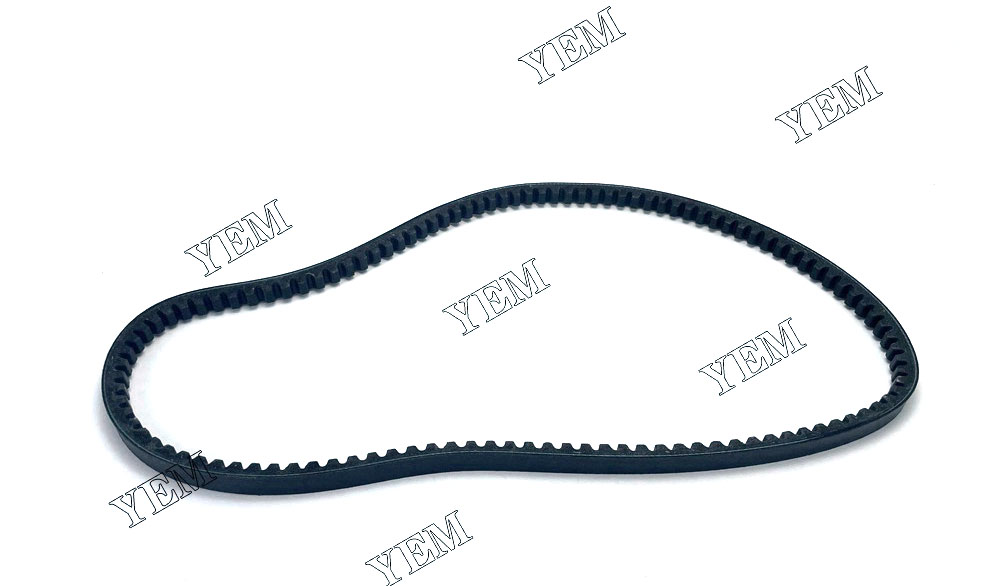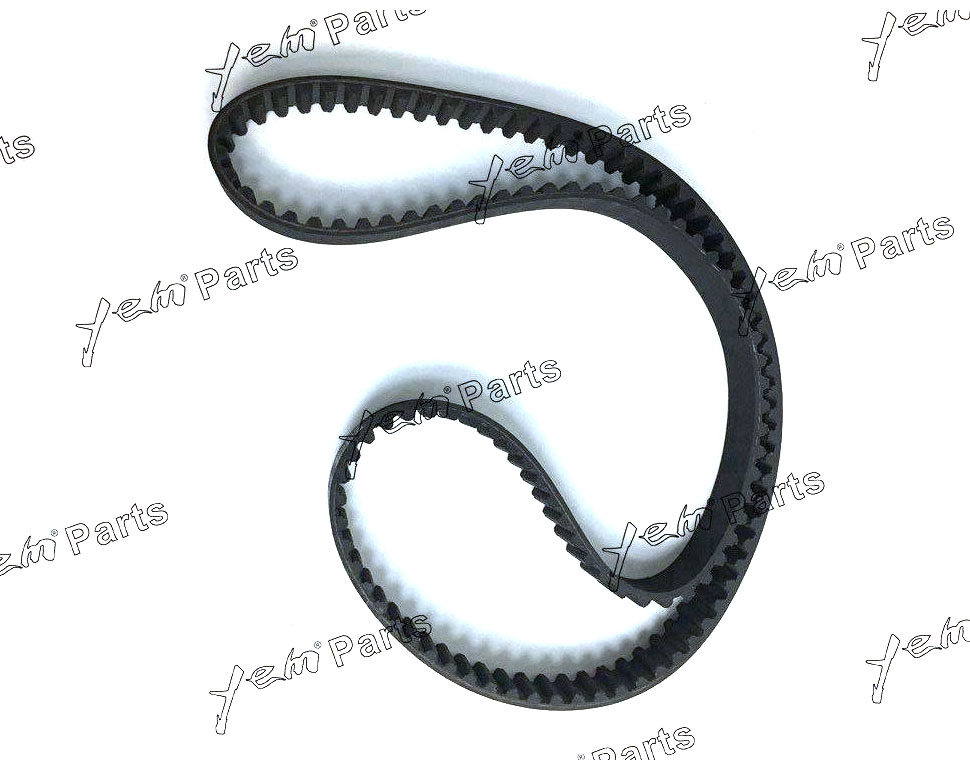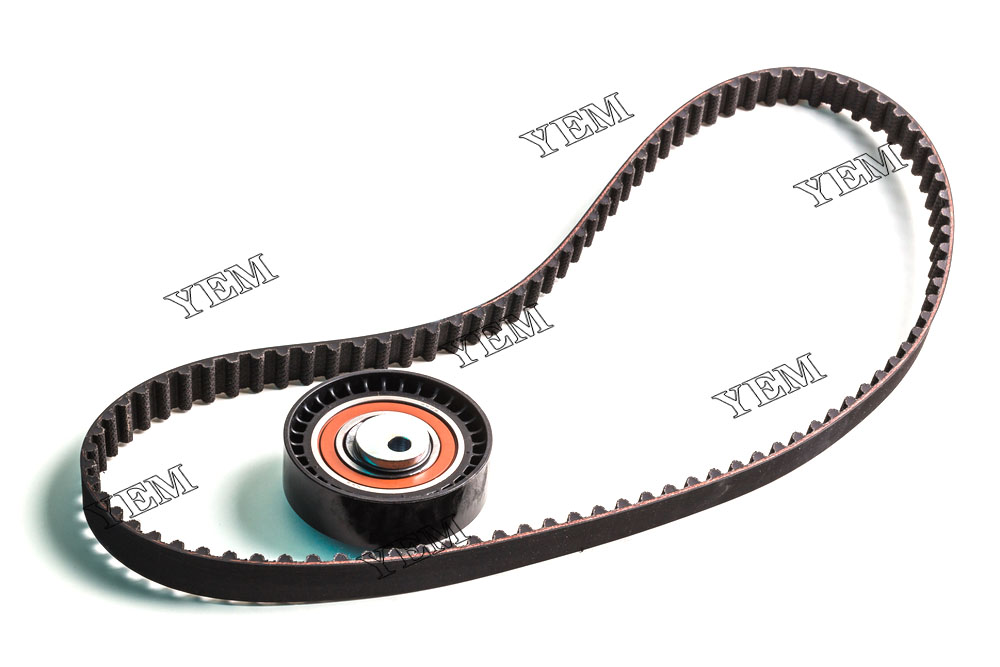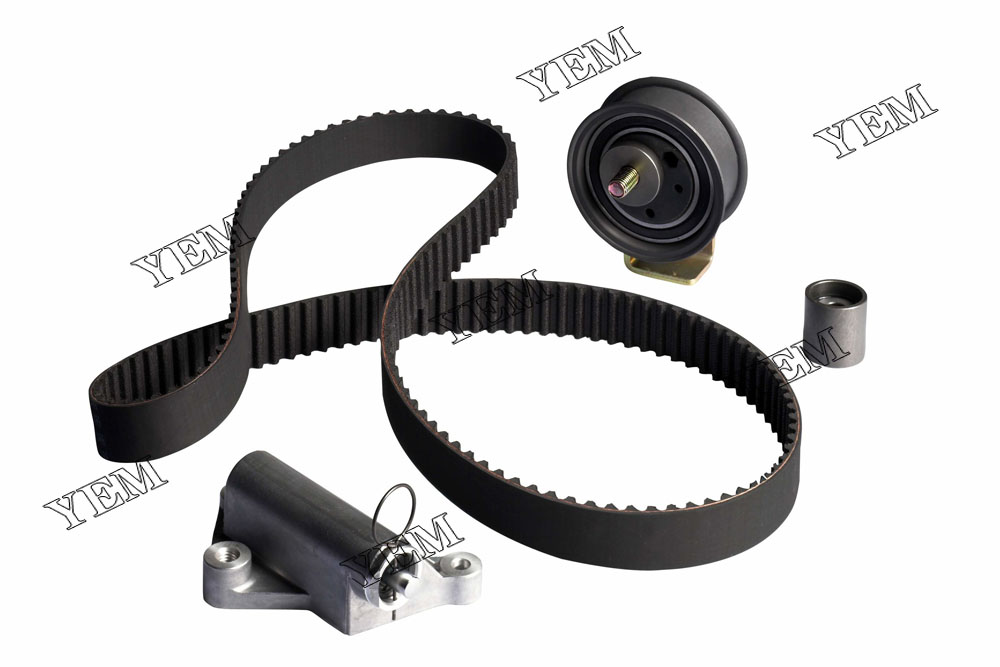What is an engine V-belt
An engine V-belt is a belt used to transmit power, usually made of materials such as rubber and fiber. It is installed in the drive system of the engine to connect and transmit power to key components such as the crankshaft, camshaft, fan, and water pump.
The name of the V-belt comes from its cross-sectional shape, which presents a “V” shape, hence the name. This shape facilitates greater contact area and friction, allowing the belt to efficiently transmit the power and torque required by the engine.
The working principle of V-belts is based on friction and tension. When the engine is running, the crankshaft drives the belt to generate rotational force and transmits it to the camshaft to control the opening and closing of the valves. At the same time, the belt can also drive the operation of auxiliary equipment such as fans and water pumps.
For the engine to run properly, the V-belt needs to be properly tensioned and in the correct installation position. Regular inspection and replacement of worn or loose V-belts is one of the important measures to maintain engine performance and reliability.
Types of V-belts
There are several different types of V-belts, which are mainly classified according to their purpose and field of application. Here are a few common V-belt types:
- Drive belt: The drive belt is the most common type of V-belt, used to transmit the power and torque of the engine to other drive system components, such as camshafts, water pumps, air-conditioning compressors, etc. They are usually made of rubber and polyester thread fabric, which are resistant to abrasion and stretching.
- Crankshaft belt: The crankshaft belt connects the engine crankshaft and camshaft, and is used to control the opening and closing time of the valves to ensure the normal valve movement and valve timing of the engine. Crankshaft belts are usually made of rubber and fiberglass reinforced materials for high tensile and abrasion resistance.
- Fan Belt: The fan belt is used to drive the auxiliary fan of the engine to provide cooling air circulation and heat dissipation. These belts are usually longer and wider to accommodate larger diameter fans. They are constructed of materials such as rubber and polyester woven fabrics that are resistant to high temperatures and chemicals.
- Shock absorber belt: The shock absorber belt is used to reduce the vibration and noise generated when the engine is running, providing smoother power transmission. These belts usually have a special shock-absorbing design to reduce vibration and shock during operation. They are usually made of materials such as rubber and polyester thread fabric.
The above are some common V-belt types, each type has different characteristics and uses. When selecting and replacing V-belts, the appropriate type and specification should be selected based on specific application requirements and manufacturer’s recommendations.

How V-belts work
The working principle of the V-belt is based on friction and tension, and it plays a key role in transmitting power and torque in the engine. Here is a brief explanation of how V-belts work:
- Belt Tensioner: The belt tensioner in the engine ensures that the V-belt is always under proper tension for efficient transmission. Tensioners typically employ a spring and pulley mechanism that automatically adjusts the tension of the belt based on operating conditions.
- Pulley: The pulley in the engine is a circular rim for the V-belt to pass around, and the pulley contacts the belt to form friction. Engines usually have different pulleys such as crankshaft pulley, camshaft pulley, fan pulley etc. which are connected to the corresponding components to enable power transmission to these components.
- Power transmission: When the engine is running, the pulley driven by the crankshaft rotates, and the V-belt contacts and tightly combines with the pulley. Through friction, power is transferred from the pulley of the crankshaft to the pulleys of other components, such as camshaft pulleys, fan pulleys, etc.
- Power control: The V-belt can control the movement of some parts in the engine, such as the camshaft pulley controls the opening and closing of the valve, the fan pulley controls the speed of the radiator fan, etc. By adjusting the diameter and number of pulleys, the motion control of different parts can be realized.
In general, V-belts transmit power and torque through friction between the pulleys, allowing the various parts of the engine to function properly. Proper tension and proper installation are important factors in ensuring that V-belts work effectively. Regular inspection and maintenance of V-belt tension and wear, as well as timely replacement of aged or worn V-belts, are essential to keep the engine running properly.
V-belt care and maintenance
To ensure the proper functioning of V-belts and prolong their life, here are some important considerations for maintaining and maintaining V-belts:
- Regularly check the tension: The correct tension of the V-belt is the key to ensure normal transmission and reduce wear. Ensure that the belt maintains proper tension during operation by checking and adjusting the belt tensioner. Regularly check belt tension and adjust as necessary, according to the manufacturer’s recommendations.
- Check for wear and damage: Periodically inspect the surface condition of the V-belt, looking for any obvious signs of wear, cracks, or other damage. If any problems are found, replace the belt in time. Regular inspection and replacement of aging belts can prevent sudden failure and avoid damage to other engine components.
- Clean the belt and pulleys: Regularly clean the V-belt and pulleys to prevent the accumulation of dust, grease or other dirt. Use a suitable cleaning agent and a soft brush for cleaning, avoid using solvents or acidic ingredients, so as not to damage the belt and rubber material.
- Pay attention to temperature and vibration: Avoid exposing the V-belt to excessive temperature and severe vibration, these factors may cause premature belt aging and damage. Make sure the engine cooling system is functioning properly, avoid overheating, and check and repair any sources of vibration.
- Periodic replacement: V-belts should be replaced regularly according to the manufacturer’s recommendations. Belts age over time, even without significant wear, and their elasticity and tension decrease. Follow the manufacturer’s recommended replacement intervals to replace aging belts in a timely manner to ensure reliable engine operation.
- Correct installation: When replacing or installing a new V-belt, please ensure proper installation and alignment. Use the correct tools and methods for installation according to the manufacturer’s recommendations, ensuring that the belt is properly seated between the pulleys and that the tensioner is properly adjusted.
Please note that the above are general maintenance and maintenance tips only, specific instructions may vary with different vehicles and engine types. For accurate maintenance recommendations, refer to the maintenance manual and recommendations provided by the engine manufacturer.

Identify and resolve common V-belt problems
There are some common problems you may encounter when using V-belts. Here are a few common V-belt problems and how to fix them:
- Wear and cracks: V-belts may wear and crack after prolonged use. This can cause the belt to loosen, lose its elasticity, or even break. The solution is to regularly check the condition of the belt, and replace it in time if any wear or cracks are found.
- Looseness: If the V-belt is loose, it may cause unstable transmission, engine malfunction or abnormal noise. The solution is to use the proper tools and adjust the belt tensioner according to the manufacturer’s guidelines to maintain the proper tension.
- Twisted and misaligned: If the V-belt is twisted or misaligned, it may cause the belt to fall off, poor friction or failure of the tensioning device. The solution is to check the belt installation location and alignment. If twisting or misalignment is found, the belt should be reinstalled or adjusted to ensure proper alignment.
- Noise: If the V-belt produces abnormal noise, it may be caused by looseness, wear, misalignment or dirt. The solution is to first check the tension and alignment and adjust as necessary. Also, make sure the belts and pulleys are clean to remove any dirt that could be causing the noise.
- Jumping: If the V-belt jumps or vibrates during operation, it may be caused by slack, damaged pulleys, or poor alignment. The solution is to check and adjust the tension and alignment of the belt, as well as check the condition of the pulleys and replace them if necessary.
- Burning: If the V-belt is overstretched or overheated, it may cause burning. This can be caused by excessive load or high temperature. The solution is to ensure the normal operation of the engine, avoid excessive load, check and maintain the cooling system in time, and pay attention to temperature control.
Before dealing with any V-belt issue, make sure to follow the manufacturer’s recommendations and consider seeking professional technical support or consultation. Properly identifying and resolving V-belt problems is an important step in ensuring reliable engine operation and extending belt life.
V-Belt Performance Improvements and Upgrades
Here are some common methods and techniques for improving and upgrading the performance of V-belts:
- Use high-performance materials: The use of high-performance materials can improve the wear resistance, high temperature resistance and chemical corrosion resistance of the V-belt. For example, belts can be made from reinforced fiberglass or carbon fiber to increase their strength and durability.
- Optimizing design and reducing contour resistance: By optimizing the cross-sectional shape of the V-belt and reducing contour resistance, its efficiency and transmission capacity can be improved. Design a new belt cross-section to reduce friction loss and increase transmission efficiency.
- Reduce vibration and noise: Improve the design of the V-belt system and the shock absorber, which can reduce the vibration and noise level. This improves driving smoothness and driving comfort.
- Enhanced tensioning device: optimize and upgrade the tensioning device of the belt to ensure that the belt always maintains proper tension. Use a tensioning system with better stability and reliability to ensure that the belt can operate normally under various working conditions.
- Use new technologies and processing methods: The introduction of advanced technologies and processing methods, such as laser cutting, precise twisting, etc., can improve the manufacturing quality and performance stability of the belt.
- Regular maintenance and inspection: Regular maintenance and inspection of the belt, including checking the tension, cleaning the pulley, replacing the aging belt, etc., can keep the V-belt in good working condition.
It should be noted that improving and upgrading the performance of V-belts requires comprehensive consideration of many factors, such as the actual application environment, the working needs of the vehicle, and the manufacturer’s recommendations. Before making any changes, it is recommended to consult a professional engineer or communicate with the manufacturer to ensure the rationality and effectiveness of the improvement measures.

Application areas and trends of V-belts
V-belts are widely used in various industries and fields due to their reliability, economy and applicability. Here are some common application areas and current trends:
- Automobile industry: V-belts are used in the transmission system of automobile engines, such as engine drives, air-conditioning compressor drives, generator drives, cooling pump drives, etc. The automotive industry is demanding more and more performance and reliability from V-belts.
- Industrial machinery: V-belts are widely used in various industrial machinery, such as fans, pumps, compressors, transmissions, generator sets, etc. With the development of industrial automation and intelligence, the requirements for high efficiency, precision and reliability of V-belts are also increasing.
- Agricultural machinery: V-belts are used in agricultural machinery to drive harvesters, seeders, sprinklers, etc., to provide power and transmission. In recent years, the technological upgrading and intelligent development of agricultural machinery have put forward higher requirements for the performance and durability of V-belts.
- Aerospace: V-belts are used in the aerospace field to drive various components and systems of engines, such as turbine drives, generator drives, hydraulic pump drives, etc. For the aerospace industry, the lightweight and high heat resistance of V-belts are key elements.
- Mining and construction engineering: V-belts are used in mining and construction engineering to drive conveyor belts, crushers, screening machines and other equipment to provide power and transmission. With the development of mines and construction projects, higher requirements are placed on the load capacity and durability of V-belts.
At present, the development trend of V-belts includes:
- Application of high-performance materials: adopt new high-performance materials, such as reinforced fiber composite materials, to improve the strength, wear resistance and high temperature resistance of V-belts.
- Improvement of manufacturing process: apply advanced manufacturing process and technology, such as laser cutting, precise twisting, etc., to improve the manufacturing accuracy and quality stability of the belt.
- Intelligent and digital application: Through the integration of sensors and data monitoring technology, real-time monitoring and fault warning of V-belts can be realized, and reliability and maintenance efficiency can be improved.
- Energy saving and environmental protection requirements: optimize the design of the V-belt system, reduce energy loss and vibration noise, and improve energy utilization efficiency and environmental friendliness.
- Customization and individualization requirements: With the increase in demand for different industries and specific applications, the demand for customization and individualization of V-belts is also increasing, and manufacturers will face the challenge of providing belts with various specifications and characteristics.
In general, the application and improvement trends of V-belts in various fields are dedicated to improving performance, reliability, and adaptability to meet continuously evolving industrial needs and technological advancements.
Selection and installation of V-belts
The following key factors need to be considered when purchasing and installing V-belts:
- Adaptability: Make sure that the selected V-belt matches the requirements of the application equipment and transmission system. Select the appropriate size and specification of the belt taking into account the transmission ratio, load requirements, speed requirements, etc.
- Material and performance: According to the specific application environment and working conditions, select the appropriate material and performance characteristics. For example, wear resistance, high temperature resistance, chemical corrosion resistance, etc.
- Manufacturer reputation and quality certification: Choose a manufacturer or supplier with good reputation and quality certification to ensure that the selected belt complies with relevant international standards and quality control requirements.
- Preparation before installation: Before installation, make sure the alignment of the pulley and drive system is correct, check and clean the surface of the pulley to ensure that there is no accumulated dirt or obstruction.
- Installation method: Install the belt correctly according to the installation guide and work instructions provided by the manufacturer. Pay attention to the adjustment of the tensioner to ensure that the belt maintains proper tension.
- Check and adjust the tension: After installation, check and adjust the tension of the belt. Make sure the belt maintains the proper tension while running to avoid problems caused by being too tight or too loose.
- Inspection and maintenance: Regular inspection and maintenance of V-belts, including checking tension, wear, cracks, etc. Follow the manufacturer’s recommendations for periodic replacement or repair.
Please note that the above is only a general purchase and installation guide, and the specific operation steps may vary due to different applications and devices. Make sure to follow the manufacturer’s recommendations and instructions for purchase and installation, and follow relevant safety and operating procedures. If necessary, it is recommended to consult a professional technician or contact the manufacturer for more detailed and accurate guidance.

FAQs about V-Belts
There are some common problems you may encounter when using V-belts. Here are the answers to these questions:
- What is the lifespan of a V-belt?
The life of a V-belt depends on many factors, including load conditions, operating environment, material quality and normal maintenance. Under normal circumstances, the life of a V-belt can reach thousands to tens of thousands of hours. Regularly check and perform necessary maintenance to prolong its life. - Why is the V-belt making noise?
Noisy V-belts can be caused by slack, misalignment, wear, or dirt. Adjusting tension, aligning belts, cleaning pulleys, and replacing worn belts are all ways to fix noise problems. - How to adjust the tension of the V-belt?
Adjusting the tension of a V-belt usually requires the use of a specific tensioner. Proper tension is achieved by adjusting the tensioner according to the manufacturer’s directions. Be careful not to over tighten or loosen to avoid damage to the belt and drive train. - Why is the V-belt loose?
V-belts may loosen due to long-term use, loose tensioning devices, wear or aging. Regular inspection and adjustment of tensioning devices, and timely replacement of worn belts, can avoid slack problems. - What are the possible causes of a broken V-belt?
V-belt fractures may be caused by overload, wear, cracks, overheating or prolonged use. Ensuring that loads are controlled, and that the condition of the belt is regularly checked and maintained, can reduce the risk of breakage. - Why does the V-belt jump or vibrate?
Jumping or vibrating V-belts can be caused by slack, misalignment, wear, damaged profiles, or failed tensioners, among other things. Adjusting belt tension, alignment, and replacing worn parts are all ways to fix a runout or vibration problem. - How to reduce wear and crack of V-belt?
Avoiding excessive loads, regularly checking and adjusting tension, maintaining good alignment, and avoiding the build-up of dirt and particles can all reduce V-belt wear and cracks. It is also important to replace aged or worn belts in a timely manner.
For specific problems and situations, it is recommended to refer to the specific operating instructions provided by the manufacturer and consult a professional technician to ensure that V-belt problems are correctly identified and resolved.
Contact us
YEM Professional Excavator Parts Team is a dedicated and experienced team that specializes in providing high-quality parts for excavators. With our extensive knowledge and expertise in this field, we offer a comprehensive range of parts to meet the diverse needs of our customers.
Whether you require replacement parts for hydraulic systems, engine components, chassis components, or any other excavator component, the YEM team has got you covered. We source our products from reputable manufacturers and ensure that each part meets the highest standards of quality and durability.
What sets us apart is our commitment to exceptional customer service. We understand the importance of timely support and strive to promptly respond to inquiries and requests. Our knowledgeable staff is readily available to help customers identify the correct parts for their specific excavator model and provide installation and maintenance instructions.
To contact the YEM Specialized Excavator Parts team, you can reach us through our website, email, or phone. We are dedicated to building long-term relationships with our customers and are eager to assist you with all your excavator parts needs.
